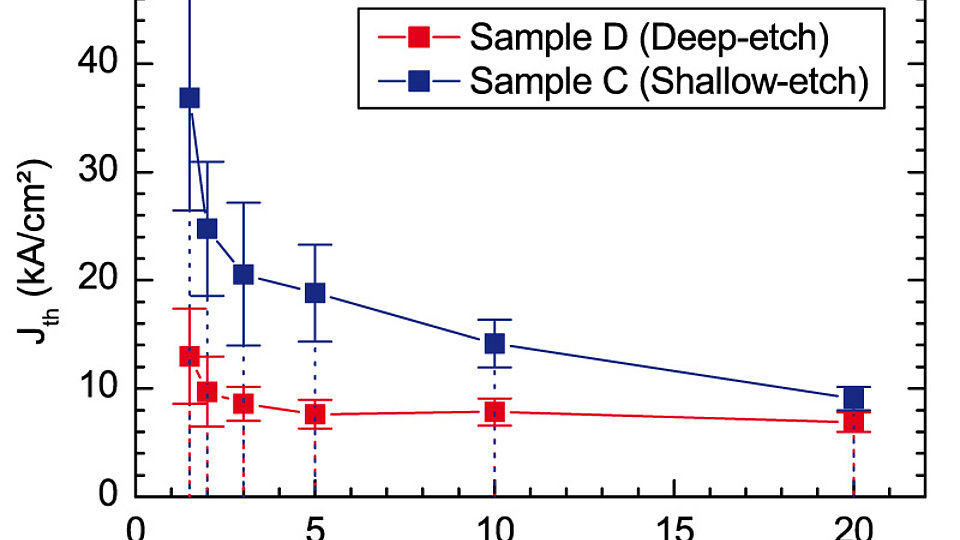Low-threshold GaN-based laser diodes
Fig. 1: Current-light power characteristic of a 44x nm RW laser diode with a ridge width of 1.5 µm under CW operation.
Laser diodes based on GaN are currently available on the market only for a limited number of specific wavelengths. FBH, together with TU Berlin und the company eagleyard Photonics, has started to develop laser diodes with customized wavelengths for use in atom spectroscopy. The current focus is on the mercury lines at 404.7 nm and 435.9 nm. The laser diodes will be operated in an external cavity, which involves a diffraction grating to precisely adjust the lasing wavelength. As required for the desired spectroscopic applications, the lasers have to show a low threshold current. Therefore, ridge waveguide (RW) laser diodes with a small ridge width of 1.5 µm and a resonator length of 600 µm have been fabricated. The narrow ridge is also essential to assure an optimum beam quality. Threshold currents as low as 40 mA have been obtained for devices emitting around 41x nm. The threshold voltage and slope efficiency in pulsed operation were 7.5 V and 0.5 W/A, respectively. Under continuous wave (CW) operation, an output power of 40 mW has been reached as shown in Fig. 1 for a device emitting at 440 nm.
A systematic study of numerous laser diodes has shown that the lasing threshold very much depends on the geometry of the ridge waveguide. The almost square-sectioned ridge waveguide is formed by etching several hundreds of nanometers deep into the semiconductor surface. Its purpose is to laterally confine both the optical mode and the vertical current path. Fig. 2 shows the threshold current density as a function of the ridge width for two batches of laser diodes whose etching depth of the ridge differs only by 175 nm. Although the impact of the ridge depth on the threshold vanishes when the ridge width increases, narrow ridge lasers exhibit more than a factor of two higher threshold current densities in case of shallow etched ridges. Systematic near field and far field measurements along with two-dimensional electro-optical simulations of the devices have been started in collaboration with the NUSOD institute. The anti-guiding effect originating from the high carrier density during lasing, the optical absorption in the region of the lateral mode tails, and the lateral current spreading are considered. Although a comprehensive explanation of the effect still needs to be found, a huge current spreading in the layer structure seems to be unlikely. Rather, the weakening of the mode confinement by the anti-guiding effect is currently favored.
Publications:
L. Redaelli, J. Piprek, M. Martens, H. Wenzel, C. Netzel, A. Linke, Y. V. Flores, S. Einfeldt, M. Kneissl and G. Tränkle, "Effect of ridge waveguide etch depth on laser threshold of InGaN MQW laser diodes", Proc. SPIE, to be published in 2012.
C. Netzel, S. Hatami, V. Hoffmann, T. Wernicke, A. Knauer, M. Kneissl and M. Weyers
"<link /fileadmin/fbh-berlin/english/ver11/pub60.htm - internal-url-new-window>GaInN quantum well design and measurement conditions affecting the emission energy S-shape", phys. stat. sol. (c), vol. 8, no. 7-8, pp. 2151-2153 (2011).
FBH research: 31.01.2012

